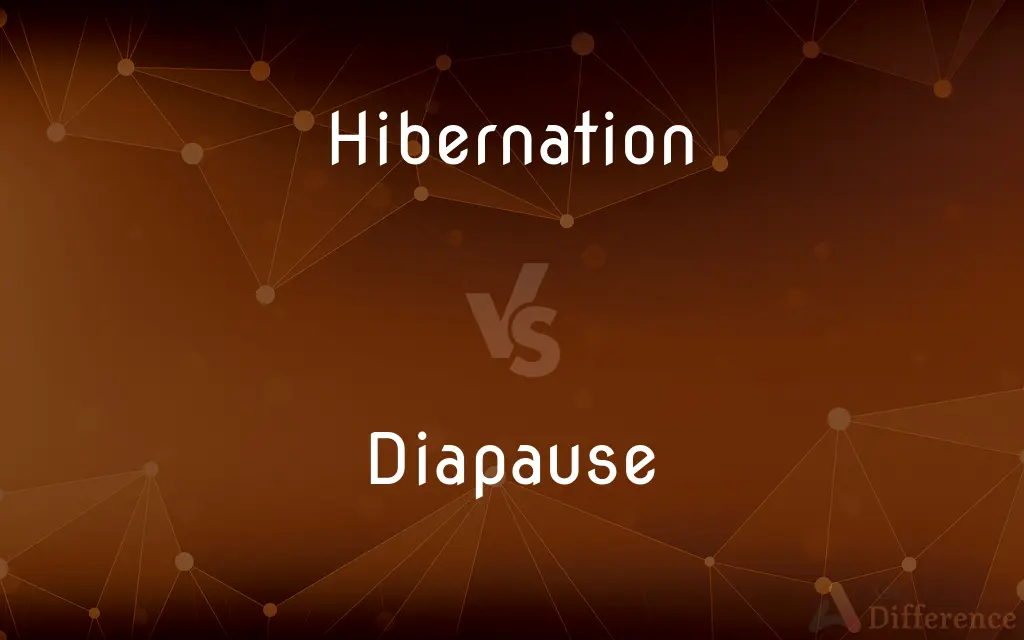Hibernation vs. Diapause — What's the Difference?
By Fiza Rafique & Urooj Arif — Updated on March 8, 2024
Hibernation is a state of inactivity and metabolic depression in animals during winter, while diapause is a period of suspended development in response to adverse environmental conditions.

Difference Between Hibernation and Diapause
Table of Contents
ADVERTISEMENT
Key Differences
Hibernation is characterized by a significant reduction in metabolic rate, body temperature, and physical activity, allowing animals to conserve energy during times when food resources are scarce, typically in winter. On the other hand, diapause is a form of dormancy that can occur in various life stages of an organism (e.g., embryo, larva, pupa, or adult) and is triggered by environmental cues such as changes in temperature, daylight, or food availability, not limited to cold seasons.
While hibernation is primarily observed in warm-blooded animals like bears, bats, and some rodents, enabling them to survive the cold months without the need for constant food intake, diapause is a strategy employed by a wide range of organisms, including insects, fish, and even some mammals, to pause developmental processes until favorable conditions return.
The trigger for hibernation is often the decrease in temperature and the availability of food as winter approaches, prompting animals to find a suitable place to enter this dormant state. In contrast, diapause can be initiated by a variety of environmental signals, and the organism's development is halted at a specific stage, which is genetically determined and can vary widely among species.
Recovery from hibernation is typically triggered by warmer temperatures and increased availability of food in the environment, leading animals to resume their normal metabolic rates and activities. Diapause, however, can end when the specific environmental condition that initiated it is reversed or when another specific cue is received, allowing the organism to continue its development or reproductive cycle.
Both hibernation and diapause serve as survival strategies in response to environmental challenges, but they differ significantly in their mechanisms, triggers, and the types of organisms that utilize these strategies.
ADVERTISEMENT
Comparison Chart
Definition
State of inactivity and metabolic depression
Period of suspended development
Purpose
Energy conservation during scarce food resources
Survival during adverse environmental conditions
Typical Organisms
Warm-blooded animals like bears, bats, and rodents
Insects, fish, and some mammals
Trigger
Cold temperatures, food scarcity
Various environmental cues (temperature, daylight)
Seasonality
Typically winter
Can occur in any season depending on the species
Recovery
Triggered by warmer temperatures, food availability
Ends with specific environmental changes or cues
Developmental Stage
Adult stage or preparing for adult stage
Any life stage depending on the species
Compare with Definitions
Hibernation
A period of deep sleep and reduced metabolism in animals during winter.
Bears enter hibernation to conserve energy when food is scarce.
Diapause
Can occur at various life stages, depending on the species.
Some fish eggs remain in diapause until conditions improve.
Hibernation
Characterized by a significant drop in body temperature and heart rate.
During hibernation, a bear's heart rate can drop significantly.
Diapause
A suspension of development in response to unfavorable environmental conditions.
Many insect larvae enter diapause during winter.
Hibernation
Allows animals to survive long periods without eating.
Hibernating animals use stored fat reserves to survive the winter.
Diapause
A strategy employed by a wide range of organisms.
Diapause helps desert plants survive prolonged periods of drought.
Hibernation
Ends with the arrival of warmer temperatures.
Groundhogs emerge from hibernation as an early sign of spring.
Diapause
Triggered by environmental cues such as temperature changes.
Shortening daylight hours can trigger diapause in some species.
Hibernation
Observed in warm-blooded animals.
Some species of bats hibernate in caves to escape the cold.
Diapause
Ends when conditions are favorable again.
Diapause in mosquito larvae ends with the onset of the rainy season.
Hibernation
Hibernation is a state of minimal activity and metabolic depression. Hibernation is a seasonal heterothermy characterized by low body-temperature, slow breathing and heart-rate, and low metabolic rate.
Diapause
In animal dormancy, diapause is the delay in development in response to regularly and recurring periods of adverse environmental conditions. It is a physiological state with very specific initiating and inhibiting conditions.
Hibernation
To be in a dormant or torpid state during a cold period, especially during the winter.
Diapause
A period during which growth or development is suspended and physiological activity is diminished, as in certain insects in response to adverse environmental conditions.
Hibernation
To be in an inactive or dormant state or period
"In Lawrenceville people hibernated and life passed them by" (Jacqueline Susann).
Diapause
A temporary pause in the growth and development of an organism due to adverse environmental conditions (especially in insects and in the embryos of many of the oviparous species of fish in the order Cyprinodontiformes)
Hibernation
A state of minimum power consumption, inactivity and metabolic depression in some animals during winter.
Hibernation
A hypothetical state of minimum power consumption, inactivity and metabolic depression in humans during long space flights.
Hibernation
(computing) A standby state which conserves power by writing the contents of the memory to disk and completely power off the computer, in order that one will resume the session from the disk.
Hibernation
The act or state of hibernating.
Hibernation
The torpid or resting state in which some animals pass the winter
Hibernation
Cessation from or slowing of activity during the winter; especially slowing of metabolism in some animals
Hibernation
The act of retiring into inactivity;
He emerged from his hibernation to make his first appearance in several years
Common Curiosities
What is the main purpose of hibernation?
The main purpose of hibernation is to conserve energy during winter when food resources are scarce.
How do animals know when to end hibernation?
Animals end hibernation in response to warmer temperatures and increased food availability, signaling the end of winter.
Is diapause the same as hibernation?
No, diapause is not the same as hibernation. Diapause is a suspension of development, while hibernation is a state of reduced metabolic activity.
What triggers diapause in insects?
Diapause in insects can be triggered by environmental cues such as changes in temperature, daylight, or food availability.
Is diapause a conscious decision by the organism?
Diapause is not a conscious decision but a genetically programmed response to environmental cues.
How do scientists study diapause?
Scientists study diapause by observing changes in developmental stages, physiological states, and responses to environmental cues in controlled settings.
What happens to an organism's growth during diapause?
Growth and development are suspended during diapause, resuming once favorable conditions return.
Can diapause occur in summer?
Yes, diapause can occur in any season, depending on the species and the specific environmental cues they respond to.
How does hibernation affect an animal's body?
Hibernation significantly reduces an animal's metabolic rate, body temperature, and overall physical activity.
Can diapause affect the lifespan of an organism?
Diapause can extend the lifespan of an organism by pausing development during adverse conditions, effectively prolonging the organism's life stage.
Can hibernation be induced artificially?
Some research is exploring artificially inducing hibernation-like states for medical purposes, but it is not widely practiced outside of experimental settings.
How do animals prepare for hibernation?
Animals prepare for hibernation by increasing their food intake to build up fat reserves that will sustain them through the dormant period.
What impact does climate change have on hibernation and diapause?
Climate change can disrupt the timing and duration of hibernation and diapause, affecting the survival and reproductive cycles of organisms.
Are there any risks associated with hibernation?
Hibernation can be risky if the animal does not have sufficient fat reserves or if it is disturbed, leading to depletion of energy stores.
Share Your Discovery

Previous Comparison
Till vs. Still
Next Comparison
Embellishment vs. DecorationAuthor Spotlight
Written by
Fiza RafiqueFiza Rafique is a skilled content writer at AskDifference.com, where she meticulously refines and enhances written pieces. Drawing from her vast editorial expertise, Fiza ensures clarity, accuracy, and precision in every article. Passionate about language, she continually seeks to elevate the quality of content for readers worldwide.
Co-written by
Urooj ArifUrooj is a skilled content writer at Ask Difference, known for her exceptional ability to simplify complex topics into engaging and informative content. With a passion for research and a flair for clear, concise writing, she consistently delivers articles that resonate with our diverse audience.















































